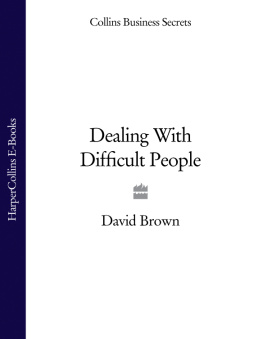
The Art and Science of
Dealing with
Difficult People
About the author
David Brown, MCIPD, studied
mechanical engineering at
Loughborough University and
secured a diploma in Management
Studies from the University of
Aston. For the last 20 years he has
been a consultant and coach
specializing in improving business
performance.
Authors note
David has a diploma in Neuro
Linguistic Programming (NLP),
which offers an insight into
behaviours and relationship
building. For more information visit
www.scott-brown.co.uk. David
wishes to acknowledge the
considerable contribution made by
his associate, Norman Leet, in the
writing of this book.
The Art and Science of
Dealing with
Difficult People
David Brown, MCIPD
Skyhorse Publishing
Copyright 2011 by David Brown
All Rights Reserved. No part of this book may be reproduced in any manner without the express written consent of the publisher, except in the case of brief excerpts in critical reviews or articles. All inquiries should be addressed to Skyhorse Publishing, 307 West 36th Street, 11th Floor, New York, NY 10018.
Skyhorse Publishing books may be purchased in bulk at special discounts for sales promotion, corporate gifts, fund-raising, or educational purposes.
Special editions can also be created to specifications. For details, contact the Special Sales Department, Skyhorse Publishing, 307 West 36th Street, 11th Floor, New York, NY 10018 or info@skyhorsepublishing.com.
Skyhorse and Skyhorse Publishing are registered trademarks of Skyhorse Publishing, Inc., a Delaware corporation.
www.skyhorsepublishing.com
10 9 8 7 6 5 4 3 2 1
Library of Congress Cataloging-in-Publication Data is available on file.
ISBN: 978-1-61608-363-2
Printed in the United States of America
Contents
Introduction
1 Understand what makes us tick
1.1 Define what you mean by difficult
1.2 Accept that we are all different
1.3 Ensure communication is two-way
1.4 Manage change
1.5 Understand assertiveness
1.6 Find the causes of discord
2 Look in the mirror
2.1 Develop your emotional intelligence
2.2 Understand your own reactions
2.3 Check your confidence levels
2.4 Ask yourself, How do I look to others? 32
3 Step into their shoes
3.1 First take off your own shoes
3.2 Be specific
3.3 Ask yourself how they are
different from you
3.4 Accept some differences
3.5 Focus on what motivates
3.6 Establish trust
3.7 Allow for different cultures
3.8 Tailor relationships to suit the need 50
4 Give difficult people a chance
4.1 Display leadership
4.2 Define clear outcomes
4.3 Define clear roles and measures
4.4 Reward the right activities and results 60
4.5 Reinforce appropriate behaviour
4.6 Communicate with a clear purpose
5 Use the right tool for the situation 66
5.1 Dig out the data
5.2 Diagnose the problem
5.3 Decide if there is a task-related issue 72
5.4 Form a psychological contract
5.5 Use third-party feedback
5.6 Use 360-degree feedback
5.7 Create a common framework
5.8 Promote dialogue
5.9 Understand conflict
5.10 Use psychometric profiling
6 Develop your skills
6.1 Visualize success
6.2 Give helpful feedback
6.3 Encourage feedback from others
6.4 Know the significance of body
language
6.5 Get results from meetings
6.6 Look at timelines
6.7 Get personal
6.8 Share information
6.9 Complain effectively
6.10 Use both power and influence
7 Resolve conflicts effectively
7.1 Learn together
7.2 Check your own qualities
7.3 Check the situation
7.4 Check if its the other person
7.5 Move forward together
7.6 Keep working on the differences
Jargon buster
Further reading
Work successfully
with difficult people
If someone is being difficult in a business situation, the end result is that individuals, teams or the organization as a whole will find it difficult to function effectively and be as successful as they otherwise might. This book gives you the skills to address difficult people and difficult situations.
I have been in many situations where someone has been widely considered difficult. It can make life frustrating and even deeply unpleasant. Whilst this book will offer you lots of tips about how to handle such people, we will also look a little deeper at what makes people difficult. You will be asked also to consider situations in which you might be the cause of difficult behaviour I know that I have sometimes been considered to be the difficult one, when I was quite sure that others were being difficult!
Once you understand the root of the difficulty, you can work out a remedial strategy to suit the situation. This book captures 50
secrets presented in seven chapters that provide the key to you dealing with difficult people. You need to decide which tip will help you in which situation.
n Understand what makes us tick. If you are to manage difficult behaviour successfully, you need to understand behaviour! Consider what shapes our behaviour, what behaviours you can realistically expect to change and what you cant.
The Art and Science of
Dealing with Difficult People
n Look in the mirror. You may be the problem. This chapter helps you to understand yourself and to consider how you appear to others.
n Step into their shoes. If you are to help people see the need for change, you need to understand those people and discover why they are different to you. In this chapter you will be offered tips on how to create trust and rapport before attempting change.
n Give difficult people a chance. There is a need for you to display leadership, even though sometimes you may not be the line manager.
We will look at clear outcomes, role clarity, reinforcing appropriate behaviour and helpful communication.
n Use the right tool for the situation. There are many tools that can help you manage difficult behaviour and difficult situations. Here are some of the globally accepted tools, including some psychometrics, with tips on when to use them.
n Develop your skills. This chapter draws on the previous Secrets to develop your all-round ability to deal with difficult people.
n Resolve conflicts effectively. We conclude with a series of checklists which will help you decide how to move forward with your
difficult person.
If you find yourself saying, that person is difficult, dont condemn them before you have exhausted all the p ossible strategies for dealing with difficult people covered in these secrets. You may not be able to change their personality, but you can change their behaviour.
Use these secrets to promote harmony
and deliver results.
The Art and Science of
Dealing with Difficult People

Understand
what makes
us tick

People that we label
Next page



















